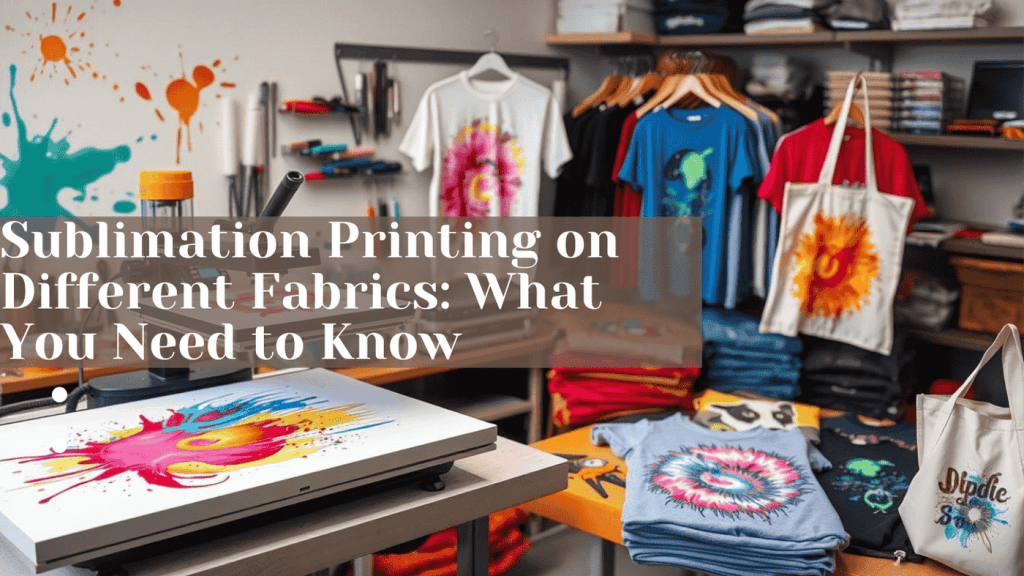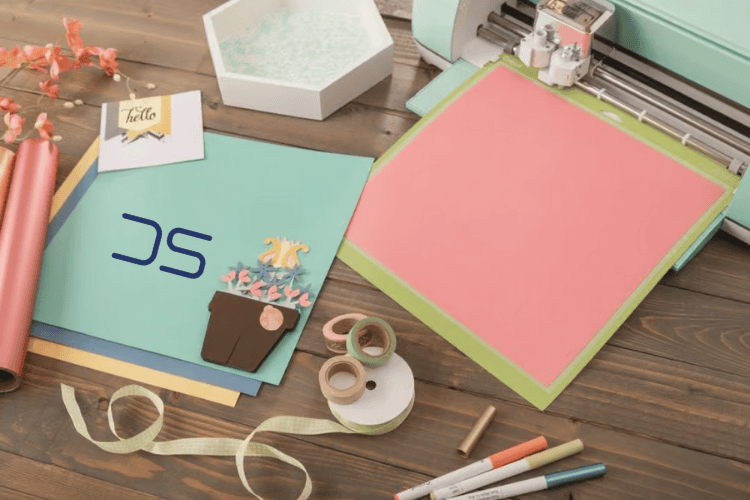Sublimation Printing on Different Fabrics: What You Need to Know
Sublimation printing transfers dye onto materials like fabrics using heat. It’s a popular choice for custom clothes, home items, and promotional stuff. Knowing how it works on various fabrics is key for top-notch, lasting prints. The printing method changes with the fabric type.
Choosing the right fabric for sublimation printing is vital. Each fabric reacts differently to the process, and some need special care. This guide will cover the basics, the best fabrics, and tips for your designs and care.
Key Takeaways
- Sublimation printing is a heat transfer technique used for custom apparel and home decor.
- Different fabric types respond differently to sublimation printing.
- Choosing the right fabric is crucial for achieving high-quality results.
- Sublimation printing techniques vary depending on the fabric used.
- Understanding the basics of sublimation printing is essential for success.
- Special printing techniques may be required for certain fabric types.
Understanding the Basics of Sublimation Printing
To start with sublimation printing, you need to know the sublimation process and what equipment is needed. The process involves printing a design on special transfer paper with sublimation ink. Then, the paper is placed on fabric, and heat is applied. This makes the ink sublimate and get into the fabric.
You’ll need a sublimation printer, a heat press, and the right materials like sublimation ink and transfer paper. Knowing how sublimation works helps you get the best results on different fabrics and designs.
What is Sublimation Printing?
Sublimation printing lets you print full-color designs on various fabrics. It’s great for making custom clothes, home items, and accessories.
The Science Behind the Process
The sublimation process uses a chemical reaction. When the ink is heated, it turns from solid to gas. This gas then gets into the fabric, making a lasting design.
Required Equipment and Materials
Here’s what you need for sublimation printing:
- Sublimation printer
- Heat press
- Sublimation ink
- Transfer paper
- Fabric (preferably polyester or polyester blends)
Learning about sublimation printing helps you make high-quality custom items. You can create vibrant and lasting designs with the right sublimation process, printing equipment, and materials.
Best Fabrics for Sublimation Printing
Choosing the right fabric is key for sublimation printing. Polyester stands out because it can handle high temperatures well. It also loves sublimation ink, making prints bright and lasting.
Cotton and other natural fibers are harder to work with. They might not last as long or look as vibrant as polyester. But, with the right treatments, you can still get great results on cotton and other fabrics. Synthetic blends offer a mix of polyester’s benefits and cotton’s feel.
Polyester has several advantages for sublimation printing:
- It can handle high temperatures.
- It absorbs sublimation ink well.
- It makes prints durable and colorful.
Cotton and synthetic blends can work too, but they need special care. Knowing your fabric’s properties helps pick the best one for sublimation printing.
Understanding fabrics like polyester, cotton, and synthetic blends helps you make better choices. This way, you can get the best results for your sublimation printing projects.
Polyester: The Perfect Canvas for Sublimation
Polyester fabric is the top pick for sublimation printing. It absorbs ink well and keeps colors bright. This makes polyester a great choice for vibrant, lasting prints.
There are many polyester fabrics, like spun and filament polyester. Each has its own benefits for sublimation. For example, spun polyester is soft and durable. Filament polyester is strong and wrinkle-free.
Why Polyester Works Best
Polyester stands up to high temperatures without losing its shape or color. This makes it perfect for detailed designs. It also can be treated to improve sublimation printing.
Different Types of Polyester Fabrics
Polyester fabrics come in various types, each with its own strengths and weaknesses. Here’s a quick look at some:
| Fabric Type | Characteristics | Suitability for Sublimation |
|---|---|---|
| Spun Polyester | Soft, durable, breathable | Excellent |
| Filament Polyester | Strong, wrinkle-resistant, easy to clean | Good |
| Polyester Blends | Combines benefits of different fibers, affordable | Fair |
In summary, polyester is a top choice for sublimation printing. Knowing the different types helps you pick the best fabric for your project.
Working with Synthetic Fabric Blends
Sublimation printing on synthetic fabric blends is a good mix of durability and comfort. These blends mix synthetic and natural fibers. The outcome can change based on the blend’s makeup. Usually, blends with more polyester work better because polyester holds colors well and can handle heat.
To get the best results, try different fabrics, inks, and heat settings. Sublimation on blends needs a careful mix of these to look great. Here are some tips to keep in mind:
- Choose a blend with a high polyester content (at least 80%) for optimal results
- Adjust the heat settings according to the fabric type and blend composition
- Use high-quality sublimation ink specifically designed for synthetic fabrics
By following these tips and trying out different synthetic blends and fabric blends, you can get professional-looking prints. Always test a small area first to make sure the results are the best.
| Fabric Blend | Polyester Content | Sublimation Results |
|---|---|---|
| 80% Polyester / 20% Cotton | 80% | Excellent |
| 60% Polyester / 40% Cotton | 60% | Good |
| 40% Polyester / 60% Cotton | 40% | Fair |
Natural Fabrics and Sublimation: What to Expect
Sublimation printing on natural fabrics like cotton comes with its own set of challenges. The process needs special care because cotton doesn’t bond well with sublimation ink. This leads to less bright colors and a higher chance of fading. But, with the right steps, you can still get good results.
One big issue with sublimation on cotton is its lower heat tolerance. This means you have to be very careful with the heat settings to avoid damaging the fabric. Also, the ink might not soak into the fabric as well, making the print less durable. To fix this, you can use special treatments and coatings on natural fabrics. These make them more ready to accept sublimation ink.
Cotton and Its Limitations
Cotton is a favorite natural fabric, but it’s not the best for sublimation printing. Its fibers tend to fade and change color, which can mess up the print’s quality. But, with the right treatment, cotton can still work for sublimation, giving a special look and feel.
Alternative Solutions for Natural Fabrics
If you want to print on natural fabrics, there are other ways to do it. Some makers have special coatings and treatments for natural fibers. These help the fibers bond better with sublimation ink. This makes the print more durable and color-stable, making natural fabrics a good choice for sublimation.
Knowing the limits and possibilities of natural fabrics like cotton helps in getting top-notch sublimation prints. With the right methods and treatments, sublimation on cotton and other natural fabrics can lead to unique and appealing results. This opens up more creative options for designers and printers.
Essential Temperature and Pressure Settings
Getting the right temperature and pressure settings is key for sublimation printing. Different fabrics need specific settings to avoid damage. Temperature settings affect how fast the ink transfers to the fabric.
Polyester needs higher temperature settings than cotton or blends. Pressure settings are also crucial. Too little pressure can lead to incomplete ink transfer, while too much can damage the fabric. The timing of the heat press is also important to ensure the ink fully sublimates without damage.
Here are some general guidelines for temperature settings and pressure settings for different fabrics:
- Polyester: 400°F (200°C) and 40-60 psi
- Cotton: 350°F (175°C) and 20-40 psi
- Blends: 375°F (190°C) and 30-50 psi
Remember, the timing of the heat press is also crucial. Start with a shorter timing and adjust as needed for the best results.
By following these guidelines and adjusting the temperature settings, pressure settings, and timing as needed, you can achieve professional-looking results with your sublimation printing projects.
| Fabric Type | Temperature Settings | Pressure Settings | Timing |
|---|---|---|---|
| Polyester | 400°F (200°C) | 40-60 psi | 60-90 seconds |
| Cotton | 350°F (175°C) | 20-40 psi | 30-60 seconds |
| Blends | 375°F (190°C) | 30-50 psi | 45-90 seconds |
Common Sublimation Printing Mistakes and Solutions
Sublimation printing can lead to common mistakes that ruin the final product’s quality. To get professional results, it’s key to spot these errors and fix them. Troubleshooting means figuring out the problem and finding the best solutions.
Some frequent problems include wrong temperature or pressure, not enough ink, or the wrong fabric. To solve these, you need to understand how to troubleshoot. This might mean tweaking the print settings, treating the fabric first, or picking different ink types.
Here are some ways to dodge common mistakes in sublimation printing:
- Choose the right fabric for sublimation printing
- Adjust temperature and pressure based on the fabric
- Use top-notch ink and make sure you have enough
By following these tips and knowing how to troubleshoot, you can avoid common mistakes. Always keep an eye on your print settings. Be ready to tweak them as needed to get the best solutions for your sublimation prints.
Design Tips for Different Fabric Types
Understanding the fabric type is key for great sublimation printing results. Each fabric has its own traits that can change how your design looks. To get professional-looking prints, follow these tips for different fabrics.
Managing colors well is crucial since sublimation ink looks different on each fabric. Always test your colors on the fabric you’re using. Also, how you place patterns is important for a balanced design. Think about the fabric’s texture, weave, and use when placing patterns.
Here are some key considerations for designing sublimation prints on different fabrics:
- Choose colors that complement the fabric’s natural hue
- Consider the fabric’s texture and weave when selecting patterns
- Scale your design according to the fabric’s intended use
By following these design tips and considering factors like color management and pattern placement, you can create stunning sublimation prints. These prints will show off your design skills and attention to detail. Always test your designs on the specific fabric you’re working with for the best results.
Maintaining Sublimation Printed Fabrics
To keep sublimation printed fabrics looking great, follow some key maintenance and care instructions. Always wash them in cold water. Stay away from bleach and harsh cleaners. And never iron the printed parts. These steps help keep the colors bright and the fabric durability intact.
Here are some more tips to remember:
- Wash sublimation printed fabrics inside out to prevent fading
- Avoid using fabric softeners or dryer sheets, as they can affect the print quality
- Do not dry clean sublimation printed fabrics, as the chemicals can damage the print
By following these care instructions and properly maintaining your sublimation printed fabrics, you can enjoy their vibrant colors and durability for a long time. Always check the specific care instructions for the fabric type you’re working with. Some fabrics may need special care.
| Fabric Type | Care Instructions |
|---|---|
| Polyester | Wash in cold water, avoid bleach and harsh detergents |
| Cotton | Wash in cold water, avoid ironing the printed area |
Conclusion: Mastering Sublimation Printing Across Fabric Types
Mastering sublimation printing means knowing how different fabrics work. You need to understand the special traits of polyester, synthetic blends, and cotton. The secret to top-notch results is fine-tuning your methods and settings for each fabric type.
This guide has given you the tools to excel in sublimation printing on many fabric types. With practice, patience, and a flexible approach, you can create stunning, durable prints. These prints will meet the changing needs of the market.
FAQ
What is sublimation printing?
Sublimation printing involves printing a design on special transfer paper with sublimation ink. This paper is then placed on fabric. Heat is applied, causing the ink to turn into gas and embed into the fabric.
What are the best fabrics for sublimation printing?
Polyester is the top choice for sublimation printing because it absorbs ink well and keeps colors bright. Other synthetic fabrics and blends can work too, but results may differ based on fabric type.
How do I work with natural fabrics like cotton for sublimation printing?
Cotton and other natural fabrics are tricky for sublimation printing because they don’t take ink well and can’t handle high heat. But, there are special treatments that can make them work better. These treatments help the print last longer, though it won’t be as good as on polyester.
What temperature and pressure settings are required for successful sublimation printing?
Getting sublimation printing right depends on the right temperature and pressure. Each fabric needs specific settings for the best results. Also, how long you press the fabric with heat is key to making sure the ink fully absorbs without damaging the fabric.
What are some common mistakes in sublimation printing and how can they be solved?
Mistakes like wrong temperature or pressure, not enough ink, or the wrong fabric are common. Knowing how to fix these problems is crucial for great prints. Adjusting settings, treating the fabric, or using different inks can solve these issues.
How do I maintain the quality of my sublimation printed fabrics?
To keep sublimation prints looking good, follow some care tips. Wash them in cold water, avoid harsh cleaners, and don’t iron the printed areas. These steps help keep the colors bright and the fabric durable.



